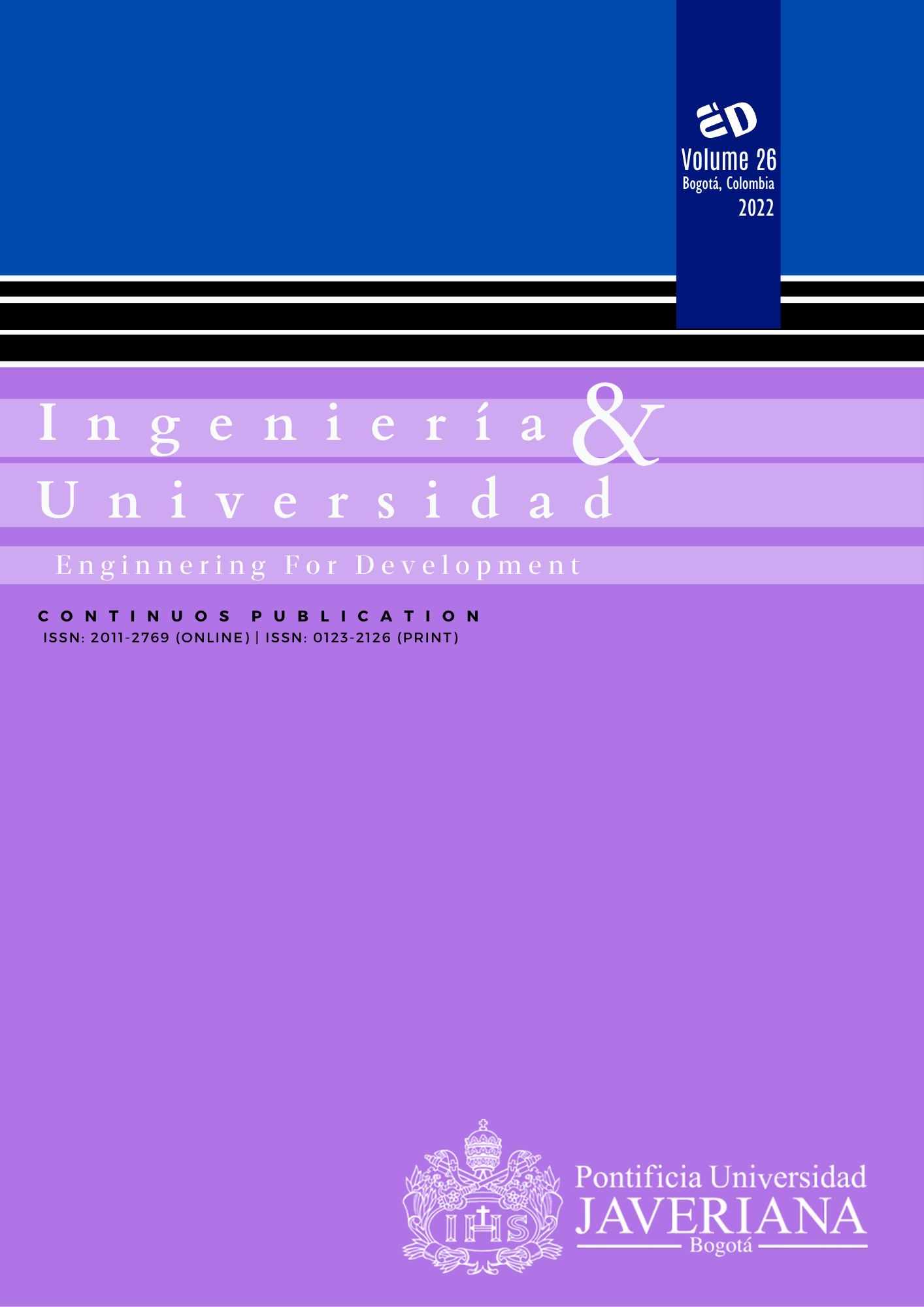Abstract
Objective: Estimate an optimal policy for the blood platelets supply chain distribution problem using a vendor-managed inventory problems approach. Methods and materials: This paper uses an integrated simulation-based optimization model to develop a Vendor-Managed Inventory approach for blood platelets. Simulation is used to estimate the performance of a defined inventory policy. On the other hand, a genetic algorithm finds optimal or near-optimal inventory policies. This approach is evaluated using a case study inspired by a real blood center in Colombia. Results and discussion: Using the proposed approach, key indicators in the blood supply chain such as total cost and outdated units are significantly improved while maintaining the service level. In terms of costs, the VMI model shows a 19.19% advantage over the non-VMI solution. Moreover, the proposed VMI solution can reduce by 42.25% the number of expired platelets. Conclusions: Using a VMI-based distribution system and a simulation-based optimization approach with genetic algorithms offers promising results in the proposed use case. This mixed methodology allows for flexible system configurations without the need for complex changes in the algorithm, and it does so without the need for excessive computational resources.
J. Beliën and H. Forcé, “Supply chain management of blood products: A literature review,” Eur. J. Oper. Res., vol. 217, no. 1, pp. 1–16, 2012, . https://doi.org/10.1016/j.ejor.2011.05.026
A. F. Osorio, S. C. Brailsford, and H. K. Smith, “A structured review of quantitative models in the blood supply chain: a taxonomic framework for decision-making,” International Journal of Production Research. Taylor & Francis, pp. 1–22, 2015, . https://doi.org/10.1080/00207543.2015.1005766
A. Pirabán, W. J. Guerrero, and N. Labadie, “Survey on blood supply chain management: Models and methods,” Comput. Oper. Res., vol. 112, p. 104756, 2019, https://doi.org/10.1016/j.cor.2019.07.014
G. Figueira and B. Almada-Lobo, “Hybrid simulation–optimization methods: A taxonomy and discussion,” Simul. Model. Pract. Theory, vol. 46, pp. 118–134, Aug. 2014, http://dx.doi.org/10.1016/j.simpat.2014.03.007
A.-T. Nguyen, S. Reiter, and P. Rigo, “A review on simulation-based optimization methods applied to building performance analysis,” Appl. Energy, vol. 113, pp. 1043–1058, 2014, https://doi.org/10.1016/j.apenergy.2013.08.061
M. Gansterer, C. Almeder, and R. F. Hartl, “Simulation-based optimization methods for setting production planning parameters,” Int. J. Prod. Econ., vol. 151, pp. 206–213, 2014, https://doi.org/10.1016/j.ijpe.2013.10.016
T. Roh, T. Lal, and T. Huschka, “Simulation based optimization: Applications in healthcare,” 2015, 10.1109/WSC.2015.7408251
R. Haijema, J. van der Wal, and N. M. van Dijk, “Blood platelet production: Optimization by dynamic programming and simulation,” Comput. Oper. Res., vol. 34, no. 3, pp. 760–779, 2007, [Online]. Available: http://www.sciencedirect.com/science/article/pii/S030505480500119X .
R. Haijema, N. van Dijk, J. van der Wal, and C. Smit Sibinga, “Blood platelet production with breaks: Optimization by SDP and simulation,” Int. J. Prod. Econ., vol. 121, no. 2, pp. 464–473, 2009, https://doi.org/10.1016/j.ijpe.2006.11.026
N. van Dijk, R. Haijema, J. van der Wal, and C. S. Sibinga, “Blood platelet production: a novel approach for practical optimization,” Transfusion, vol. 49, no. 3, pp. 411–420, 2009, https://doi.org/10.1111/j.1537-2995.2008.01996.x
J. T. Blake, N. Heddle, M. Hardy, and R. Barty, “Simplified platelet ordering using shortage and outdate targets,” Int. J. Heal. Manag. Inf., vol. 1, no. 2, pp. 145–166, 2010.
D. Zhou, L. C. Leung, and W. P. Pierskalla, “Inventory management of platelets in hospitals: Optimal inventory policy for perishable products with regular and optional expedited replenishments,” Manuf. Serv. Oper. Manag., vol. 13, no. 4, pp. 420–438, 2011, https://doi.org/10.1287/msom.1110.0334
U. Abdulwahab and M. I. M. Wahab, “Approximate dynamic programming modeling for a typical blood platelet bank,” Comput. Ind. Eng., vol. 78, pp. 259–270, 2014, https://doi.org/10.1016/j.cie.2014.07.017
D. Dalalah, O. Bataineh, and K. A. Alkhaledi, “Platelets inventory management: A rolling horizon Sim–Opt approach for an age-differentiated demand,” J. Simul., vol. 13, no. 3, pp. 209–225, 2019, https://doi.org/10.1080/17477778.2018.1497461
I. Civelek, I. Karaesmen, and A. Scheller-Wolf, “Blood platelet inventory management with protection levels,” Eur. J. Oper. Res., vol. 243, no. 3, pp. 826–838, 2015, https://doi.org/10.1016/j.ejor.2015.01.023
R. Haijema, N. M. van Dijk, and J. van der Wal, “Blood Platelet Inventory Management,” in Markov Decision Processes in Practice, R. J. Boucherie and N. M. van Dijk, Eds. Cham: Springer International Publishing, 2017, pp. 293–317. https://doi.org/10.1007/978-3-319-47766-4_10
H. Jalali and I. Van Nieuwenhuyse, “Simulation optimization in inventory replenishment: a classification,” IIE Trans., vol. 47, no. 11, pp. 1217–1235, 2015, 10.1080/0740817X.2015.1019162
C. S. Pramudyo, “Genetic Algorithm Parameters in a Vendor Managed Inventory Model,” IJID (International J. Informatics Dev., vol. 7, no. 1, p. 36, Jan. 2019, doi: 10.14421/ijid.2018.07108.
A. Beklari, M. S. Nikabadi, H. Farsijani, and A. Mohtashami, “A Hybrid Algorithm for Solving Vendors Managed Inventory (VMI) Model with the Goal of Maximizing Inventory Turnover in Producer Warehouse,” Ind. Eng. Manag. Syst., vol. 17, no. 3, pp. 570–587, 2018, [Online]. Available: http://iemsjl.org/journalarticle.php?code=63301
G. Subramaniam and A. Gosavi, “Simulation-based optimisation for material dispatching in Vendor-Managed Inventory systems,” Int. J. Simul. Process Model., vol. 3, no. 4, p. 238, 2007, https://doi.org/10.1504/IJSPM.2007.016314
W. Liu, G. Y. Ke, J. Chen, and L. Zhang, “Scheduling the distribution of blood products: A vendor-managed inventory routing approach,” Transp. Res. Part E Logist. Transp. Rev., vol. 140, p. 101964, Aug. 2020, https://doi.org/10.1016/j.tre.2020.101964
T. A. Al-Ameri, N. Shah, and L. G. Papageorgiou, “Optimization of vendor-managed inventory systems in a rolling horizon framework,” Comput. Ind. Eng., vol. 54, no. 4, pp. 1019–1047, May 2008, https://doi.org/10.1016/j.cie.2007.12.003
F.-M. De Rainville, F.-A. Fortin, M. Gardner, M. Parizeau, and C. Gagné, “DEAP: A Python framework for Evolutionary Algorithms,” in GECCO’12 - Proceedings of the 14th International Conference on Genetic and Evolutionary Computation Companion, 2012, pp. 85–92, https://doi.org/10.1145/2330784.2330799
F.-A. Fortin, F.-M. De Rainville, M.-A. Gardner, M. Parizeau, and C. Gagné, “Evolutionary Tools — DEAP 1.3.1 documentation.” 2020, Accessed: Jul. 29, 2020. [Online]. Available: https://deap.readthedocs.io/en/master/api/tools.html
A. F. Osorio, S. C. Brailsford, H. K. Smith, S. P. Forero-Matiz, and B. A. Camacho-Rodríguez, “Simulation-optimization model for production planning in the blood supply chain,” Health Care Manag. Sci., vol. 20, no. 4, pp. 548–564, 2017, https://doi.org/10.1007/s10729-016-9370-6

This work is licensed under a Creative Commons Attribution 4.0 International License.
Copyright (c) 2022 Juan David Carvajal-Hernandez, Andres Felipe Osorio-Muriel, PhD



